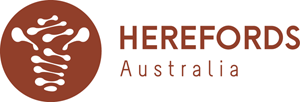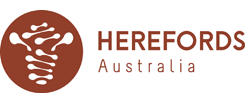In October, Marc Greening (Deputy Chair Herefords Australia) and Lisa Sharp (CEO Herefords Australia) attended the American Hereford Association (AHA) Annual Meeting in Kansas City, Missouri. The trip included attendance at the ‘Ladies of the Royal Sale,’ a National Hereford Show and meetings with staff from AHA.
The trip was an opportunity to build on the relationship between AHA and Herefords Australia (HAL) and to identify areas of common interest and potential collaboration.
The Annual Meeting was built around the AHA 2022 – 2027 Strategic Plan and initiatives. The Plan vision is to establish ‘Hereford genetics as the essential component of the U.S beef cowherd,’ with a central strategy to capitalize on the value of Hereford-influenced commercial female. Key activities in support of this strategy include investing in research to further document the value of maternal heterosis and to continue to promote the docility, efficiency, fertility, longevity, and sustainability of the Hereford-influenced female.
AHA also intend to leverage big data capabilities to collect additional phenotypes and develop new, relevant EPDs and indexes including a genetic evaluation focused on Hereford-influenced females. In follow up meetings with AHA, Herefords Australia saw examples of marketing and extension materials, that could be adapted for use in Australian campaigns. We also gained an understanding of AHA’s approach to development of new EPDs (EBVs) and indexes.
A second strategy is to document, communicate and improve Hereford’s sustainability story. Here AHA activities include leveraging existing data to communicate the breed’s efficiency advantages, engaging experts to develop a model that analyses the key drivers of the beef cattle carbon footprint, investing in GHG data collection and developing EPDs and indexes to measure and improve beef industry sustainability. We could see parallels with work currently undertaken through the Australian Beef Sustainability Framework and data being gathered through industry projects, such as southern multi-breed. The breed has efficiency advantages, particularly through longevity, fertility, and rate of gain, and this will be an area of focus – both data collection and communication – for Herefords Australia.
A third strategy is to fuel the growth of Certified Hereford Beef (CHB). This includes sustainability claims that can be made as part of the program, tracking eligible cattle, and communicating carcase performance to customers and AHA members, developing programs to grow distributor and export partners and expansion of the value added CHB product line.
While there are some key differences between the U.S and Australia, such as market structure, presence of branded beef programs and legal requirements, we could see potential application of economic sustainability claims (fertility, longevity, net feed intake). There may be opportunities to utilize U.S data to support claims or guide local data collection projects. Aspects of this strategy, mirror activities HAL has in its own 5-year Strategic Plan, including collection, benchmarking, and reporting of eating quality data.
A fourth strategy is to increase demand for Hereford-influenced feeder cattle. Again, while there are some key differences between the two country’s production and selling systems, we saw several initiatives that could be adapted for application in the Australian market. This included building relationships along the supply chain and using data to communicate the value of Hereford genetics, investing in research to collect feed efficiency and health data, and building modelling programs to quantify the relative profitability advantages of Hereford-influenced feeder cattle.
AHA have over 4000 youth members, so it is no surprise that a key strategy is to harness this and build a pipeline of future leaders. Key initiatives include an expansion of current leadership development programs and experiences, exploration of possible mentoring opportunities between adult and youth members and the development of an education program for students who are interested in jobs in the feeding, packing, processing, and food industries.
In follow up meetings, we explored the U.S intern and work experience program and discussed U.S and Australian academic exchange opportunities, with emphasis on meat science studies and other initiatives leading up to and including the World Hereford Congress (to be hosted by AHA in Kansas City in 2025). A program that caught our attention was the National Junior Hereford Association Fed Steer Shootout, which provides junior members with an opportunity to gain experience about cattle feeding and beef packing sectors while also learning how cattle perform in feedlots, through to carcase and grading.
There were many other topics we covered as part of our meetings with AHA management and staff including genetic evaluation, in-herd selection tools, the evolution of myHerd (Hereford Live), AHA publications and the expansion of creative and media services for members. You may recognize that some of these topics are similar to initiatives within Herefords Australia’s 5-year Strategic Plan and we are confident knowledge from this trip can help to inform HAL projects and operations.
We are grateful for the opportunity to attend the AHA Annual Meeting, and for the hospitality of the AHA Executive Vice President, Jack Ward, AHA Chief Operating Officer and Director of Breed Improvement, Shane Bedwell, and AHA staff, who were very generous with their time and knowledge. We look forward to building on the relationship and progressing initiatives that benefit our respective memberships and of course, the Hereford breed. To quote Tom Brink, CEO of the Red Angus Association of America (who presented alongside Jack Ward in a session called Create your Future), when it comes to collaboration ‘…. two is more than one.’









